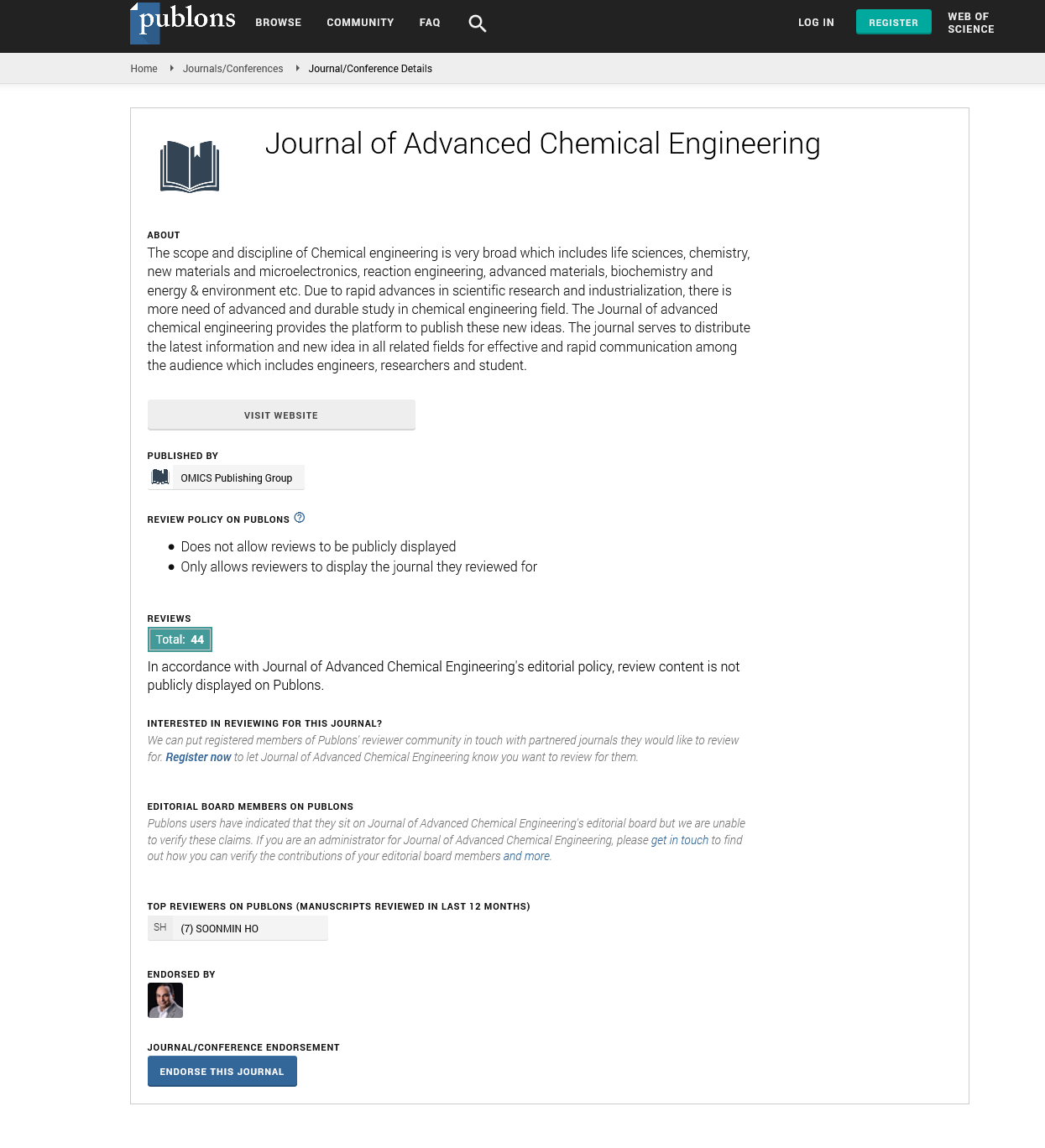Indexed In
- Open J Gate
- Genamics JournalSeek
- Smithers Rapra
- RefSeek
- Directory of Research Journal Indexing (DRJI)
- Hamdard University
- EBSCO A-Z
- OCLC- WorldCat
- Scholarsteer
- Publons
- Geneva Foundation for Medical Education and Research
- Google Scholar
Useful Links
Share This Page
Journal Flyer

Open Access Journals
- Agri and Aquaculture
- Biochemistry
- Bioinformatics & Systems Biology
- Business & Management
- Chemistry
- Clinical Sciences
- Engineering
- Food & Nutrition
- General Science
- Genetics & Molecular Biology
- Immunology & Microbiology
- Medical Sciences
- Neuroscience & Psychology
- Nursing & Health Care
- Pharmaceutical Sciences
Opinion Article - (2024) Volume 14, Issue 4
Advanced Applications: Drug Repurposing and Covalent Inhibitor Design
Abigail Miller*Received: 28-Nov-2024, Manuscript No. ACE-24-28360; Editor assigned: 02-Dec-2024, Pre QC No. ACE-24-28360 (PQ); Reviewed: 16-Dec-2024, QC No. ACE-24-28360; Revised: 23-Dec-2024, Manuscript No. ACE-24-28360 (R); Published: 30-Dec-2024, DOI: 10.35248/2090-4568.24.14.352
Description
The convergence of generative cheminformatics and ligand protein structure analysis is revolutionizing rational drug discovery by providing a computational framework to design molecules with precision and efficiency. These approaches control advances in Artificial Intelligence (AI) and molecular modeling to tackle the traditionally labor-intensive and time consuming process of identifying and optimizing therapeutic compounds. By combining molecular tweaking through generative algorithms with structural insights into ligand-protein interactions, researchers can navigate the vast chemical space with unprecedented accuracy.
Generative cheminformatics employs AI models, such as Generative Adversarial Networks (GANs) and Variational Autoencoders (VAEs), to create novel molecular structures with desired properties. These algorithms learn from existing chemical datasets and can propose molecules optimized for specific pharmacokinetic and pharmacodynamic profiles. Unlike traditional random screening methods, generative models allow for a directed exploration of chemical space, significantly reducing the time required to identify lead compounds. This molecular tweaking capability is particularly valuable in addressing challenges such as poor bioavailability, off-target effects and toxicity, which often hinder drug development.
When combined with high-resolution ligand protein structural data, generative models gain an additional layer of context. Structural analysis of ligand protein complexes reveals the precise interactions that drive binding affinity and selectivity. By incorporating this information, generative models can design molecules that exploit specific binding pockets, hydrogen bonding networks and hydrophobic interactions, ensuring a higher likelihood of success in subsequent experimental validation. This synergy between cheminformatics and structural biology enhances the rationality of drug design, moving beyond trial-and-error approaches.
One of the most impactful applications of this integrated approach is in drug repurposing and the design of covalent inhibitors. Generative models can modify existing drugs or design new compounds to target specific residues within a protein binding site. For example, tweaking molecular scaffolds to form covalent bonds with reactive amino acids, while maintaining favorable pharmacokinetics, can result in highly selective and potent inhibitors. Structural insights ensure that these modifications are feasible and biologically relevant, reducing the risk of off-target interactions.
Despite its transformative potential, the integration of generative cheminformatics and ligand protein structures faces several challenges. The accuracy of generative models depends on the quality and diversity of training datasets. Biases in these datasets can limit the novelty and applicability of generated molecules. Furthermore, structural data is not always available for all protein targets, particularly for membrane proteins or transient complexes. This limits the scope of rational design in such cases, requiring complementary approaches like homology modeling or cryo-electron microscopy.
Another consideration is the computational complexity of combining these methodologies. While generative models excel at proposing molecules, accurate prediction of their binding affinities and dynamic behavior requires strong docking and molecular dynamics simulations. Integrating these steps into a streamlined pipeline remains a technical hurdle, demanding significant computational resources and expertise. Additionally, experimental validation remains a bottleneck, as the in silicodesigned molecules must still be synthesized and tested to confirm their predicted properties.
The ethical and regulatory implications of AI-driven drug design also merit discussion. The ability of generative models to rapidly produce novel molecules raises questions about intellectual property, data privacy and the potential misuse of this technology for harmful purposes. Establishing guidelines and frameworks to govern the application of these tools is essential to ensure their responsible use.
In conclusion, molecular tweaking by generative cheminformatics, coupled with ligand–protein structural analysis, represents a change towards in rational drug discovery. By combining AI-driven innovation with the precision of structural biology, researchers can design molecules that are both efficient and effective, addressing longstanding challenges in drug development. While technical and ethical challenges remain, the continued evolution of these methodologies promises to unlock new possibilities in therapeutic innovation, ultimately improving patient outcomes and accelerating the journey from concept to clinic.
Citation: Miller A (2024). Advanced Applications: Drug Repurposing and Covalent Inhibitor Design. Adv Chem Eng. 14:352.
Copyright: © 2024 Miller A. This is an open access article distributed under the terms of the Creative Commons Attribution License, which permits unrestricted use, distribution, and reproduction in any medium, provided the original author and source are credited.

